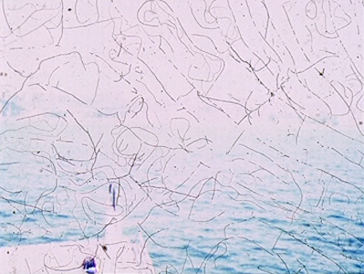
Joana Hadjithomas and Khalil Joreige were born in 1969 in Beirut (LB)
They live and work in Paris (FR) and Beirut (LB)

2003
Super 8 film transferred to DVD, color, sound
Edition 2/5 + 2 éditions d'artistes
Durée : 3 '
Year of Purchase: 2009
In 2001, in the archives belonging to his uncle who had been kidnapped on August 19, 1985, the Lebanese artist and film maker Khalil Joreige discovered an old Kodak envelope containing a Super 8 film. Lasting images is that film, finally developed by the artist and transferred onto DVD. At first approach, the mysterious film shows something akin to abstraction: fluid, evanescent traces. These damaged, cracked, and overexposed images gradually reveal a sea shore and a few ghost-like silhouettes. Nothing to see, or next to nothing. A hapless—yet riveting—ready-made. It brings to mind pioneers of experimental cinema, film scratching techniques, and certain forms of avant-garde abstraction. It also evokes expressionist painting: the creation of a haphazard motif through accidental blurring of the image. This produces a sort of optical noise, as in those blurry images that resurface in memory, somewhere between memories and dreams, between documents and fantasies. Beyond, however, or rather through, its formal aspect, the film indirectly evokes the fate of the victims of kidnapping during the Lebanese civil wars (1975–1990), who have been officially declared “missing.” The film seems a sort of visual conjuration—as if these scorched images contained a subliminal message delivered across time, like those messages believed by certain mediums to be transmitted in white noise on the TV or in radio static. Thus a chasm opens up, a zone of non-resolution that resists closure. The artists themselves comment: “Latency is the introduction to the possible, to the state of becoming.” 1 A reflection both on cinema and on history, this film introduces a disturbing paradox: a missing person is neither dead nor alive. An anti-Schrödinger’s cat of sorts, the famous metaphorical animal of quantum physics, kept in a box in its double state, dead AND alive, and whose fate is determined by opening the box. Here, the act of opening, uncovering the film determines nothing, but makes manifest a radical latency, the eternal in-between, which has its share of violence. There is an irreducible contradiction which pulls the document toward fiction, proposing a sort of romantic becoming of the political. The work thus takes a critical look at the role of the document and of the historian, positioned between objectivity and subjectivity, reality and fiction, history and History. The missing image, which becomes just an “impression,” endows the event, which the artists nonetheless usher from shadow (the film, forgetting) into light (exhibition, memory), with a ghostly character. The forced overexposure of blind spots of history relies on a disturbed persistence of vision which is characterized by an increasing abstraction of the past, but also by the vital necessity to document it, even if it means imposing forms of witnessing when witnesses had been silenced.
Guillaume Désanges
1 Joanna Hadjithomas et Khalil Joreige, Home Works: A Forum on Cultural Practices in the Region, Ashkal Alwan, Beirut, 2003, p. 40. Available at http://www.ashkalalwan.org/files/HomeWorks1_publication_eng.pdf.